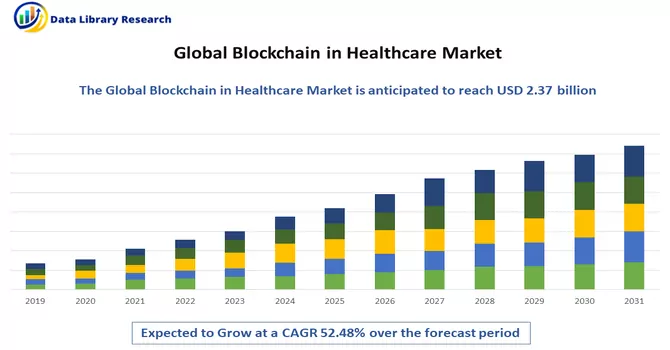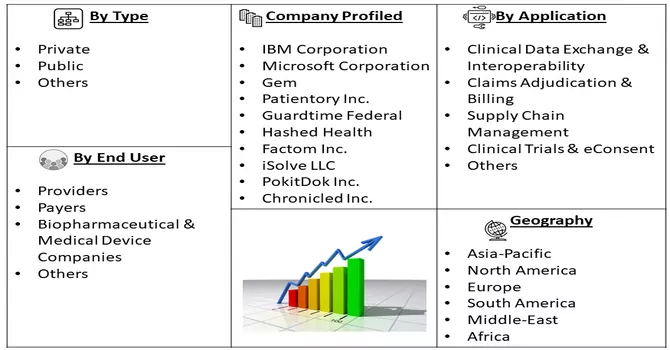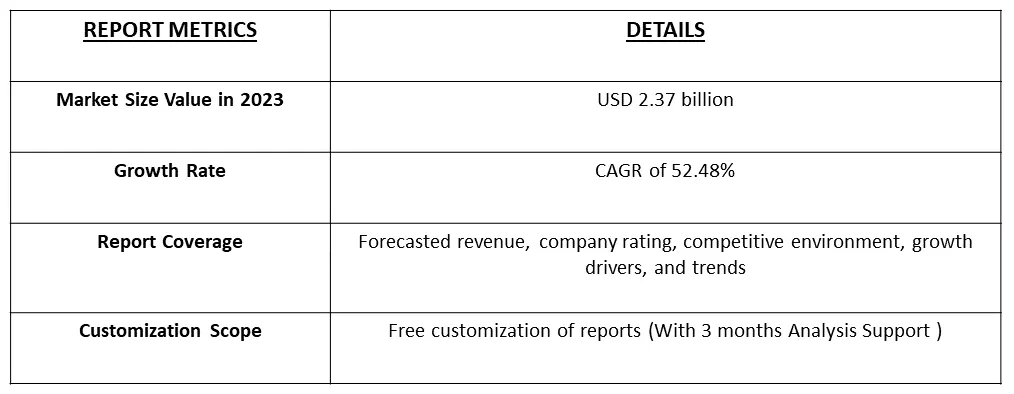The Blockchain Market in Healthcare is expected to grow from USD 2.37 billion in 2023, registering a CAGR of 52.48% during the forecast period (2023-2030).

Get Complete Analysis Of The Report - Download Free Sample PDF
Blockchain technology has emerged as a revolutionary force in the healthcare industry. It offers secure, transparent, and tamper-proof data management solutions, addressing critical issues such as data breaches and interoperability.
The factors that are driving the growth of the studied market are increasing data breaches in the healthcare industry and government mandates regarding maintaining medicine quality.
The blockchain market in healthcare is continually evolving, driven by technological advancements and the industry's growing recognition of the potential benefits of blockchain technology. Blockchain is being used to address the issue of interoperability in healthcare by creating a secure and standardized way to exchange patient data between different systems and healthcare providers. This trend aims to improve care coordination and enhance patient outcomes. Moreover, patients are increasingly demanding control over their healthcare data. Blockchain allows patients to have ownership of their data and grants access to healthcare providers as needed, enhancing data security and privacy.

For Detailed Market Segmentation - Download Free Sample PDF
Drivers:
Increasing Data Breaches in the Healthcare Industry
The healthcare sector is vulnerable to data breaches, which can compromise patient privacy and result in severe financial and legal consequences. Blockchain technology provides a secure and decentralized way to store and manage patient data, reducing the risk of data breaches. The rising incidence of data breaches is driving healthcare organizations to invest in blockchain solutions for data security.
Advancements in Data Security
The growing concern over data breaches has led to increased investments in data security solutions. Blockchain's ability to provide encryption, decentralized storage, and transparency has made it an attractive option for healthcare organizations seeking robust data security measures. As regulations become stricter, the adoption of blockchain technology is expected to accelerate the growth of the studied market.
Restraints:
Lack of Awareness Regarding Blockchain Functionality
Despite the benefits of blockchain technology, there is still a lack of awareness and understanding among healthcare professionals and organizations about its functionality and implementation. This lack of awareness hinders the widespread adoption of blockchain solutions in healthcare.
The COVID-19 pandemic not only brought challenges to the healthcare sector but also accelerated the adoption of blockchain technology as a valuable tool to enhance data security, interoperability, and overall healthcare system resilience. The pandemic highlighted the need for digital solutions in healthcare. Blockchain, known for its secure data-sharing capabilities, gained more attention as a way to strengthen healthcare systems. Moreover, in the current scenario, with the rise of telehealth and remote patient monitoring during the pandemic, ensuring the security and privacy of healthcare data has become crucial. Blockchain's features, like data encryption and immutability, helped address these concerns. Thus, the market is expected to witness significant growth over the forecast period.
Segmental Analysis:
Counterfeit Proofing and Data Protection is Expected to Witness Significant Growth Over the Forecast Period
The World Health Organization (WHO) estimates that numerous countries in Africa, parts of Asia, and Latin America face the challenge of counterfeit medicines, with more than 30% of drugs being fake in some areas. The incidents of substandard or counterfeit medicines are on the rise and can be attributed to various factors. One significant factor is the complexity of pharmaceutical supply chains, which are susceptible to risks due to the involvement of under-regulated wholesalers, illicit distributors, non-legitimate internet pharmacies, and multiple global importation routes.
Blockchain-based connected supply chains are being developed to combat the issue of counterfeiting by enabling the sharing and access of health-related data, software code, metadata, and other healthcare products. For example, in 2002, the Pharmaceutical Security Institute (PSI) reported 196 incidents of pharmaceutical crime. However, the annual number of such incidents has seen a substantial increase over time, reaching nearly 6,000 in the past year.
Furthermore, there is an expectation that increased investments in the development of effective medical examination systems, wearable device cryptography, and healthcare record systems will create lucrative opportunities in the market. In the event of a product recall, manufacturers must communicate swiftly and transparently with all stakeholders in the supply chain, ranging from wholesalers to retail pharmacies, to retrieve faulty items. This necessitates enhanced collaboration, a goal that blockchain technology can efficiently achieve. The prevalence of diseases is anticipated to generate vast amounts of data, driving the demand for robust data management solutions. Additionally, implementing blockchain technology in medical records will ensure the integrity and immutability of healthcare data. Leading players in the industry are increasingly investing in this technology, further fueling the growth of the market.
North America is Expected to Witness Significant Growth Over the Forecast Period
North America is at the forefront of blockchain adoption in healthcare, driven by the region's advanced healthcare infrastructure and technology-oriented approach. Several healthcare providers in North America have begun implementing blockchain-based electronic health records (EHRs) to enhance data security, interoperability, and patient access. This development reflects the growing acceptance of blockchain as a critical component of modern healthcare.
Prominent technology companies in North America have partnered with healthcare organizations to develop and deploy blockchain solutions. These collaborations aim to leverage blockchain's capabilities to improve patient data management and healthcare processes. For instance, in February 2022, the Estonia-based healthcare company MAH Healthcare (Htax coin) is excited to announce the release of the HTrax currency as a step toward realizing its goal to integrate blockchain technology into the healthcare sector and digitize it. The HTrax coin is intended to power the healthcare system's digital economy and will offer incentives to diverse stakeholders. The HTrax coin is also a BEP20 standard coin that is highly safe and will be accessible to users on several exchanges.
Thus, due to the above-mentioned factors the market is expected to witness significant growth over the forecast period.

Get Complete Analysis Of The Report - Download Free Sample PDF
The blockchain market is limited due to the expertise required to implement new projects, thus creating a high entry barrier. The concentrated market allows enterprises to take advantage of specialized blockchain healthcare offerings from vendors like:
Key Players :
Recent Developments:
1) January 2022: Avaneer Health has received additional support from several prestigious healthcare institutions, providing the health network with USD 50 million in startup money. Based on blockchain technology, the network focuses on payer-to-payer data sharing, eligibility, and prior authorization while utilizing HL7's FHIR specification to increase data access among healthcare companies.
2) March 2022: Nokia stated that Equideum Health had chosen it to assist in developing and delivering healthcare use cases. Equideum Health will employ Nokia's Data Marketplace (NDM) solution, which is available through its Software-as-a-Service (SaaS) architecture. Equideum Health, a leader in the healthcare and life sciences blockchain, will be able to launch new use cases.
Q1. What is the current Blockchain in Healthcare Market size?
The Blockchain Market in Healthcare is currently valued at USD 2.37 billion.
Q2. What is the Growth Rate of the Blockchain in Healthcare Market?
Blockchain in Healthcare Market is registering a CAGR of 52.48% during the forecast period.
Q3. Which are the major companies in the Blockchain in Healthcare Market?
IBM Corporation, Microsoft Corporation, Gem and Patientory Inc. are some of the Blockchain in Healthcare Market.
Q4. Which Region is expected to hold the highest Market share?
North America region is expected to hold the highest Market share.
Data Library Research are conducted by industry experts who offer insight on industry structure, market segmentations technology assessment and competitive landscape (CL), and penetration, as well as on emerging trends. Their analysis is based on primary interviews (~ 80%) and secondary research (~ 20%) as well as years of professional expertise in their respective industries. Adding to this, by analysing historical trends and current market positions, our analysts predict where the market will be headed for the next five years. Furthermore, the varying trends of segment & categories geographically presented are also studied and the estimated based on the primary & secondary research.
In this particular report from the supply side Data Library Research has conducted primary surveys (interviews) with the key level executives (VP, CEO’s, Marketing Director, Business Development Manager and SOFT) of the companies that active & prominent as well as the midsized organization
FIGURE 1: DLR RESEARH PROCESS

Extensive primary research was conducted to gain a deeper insight of the market and industry performance. The analysis is based on both primary and secondary research as well as years of professional expertise in the respective industries.
In addition to analysing current and historical trends, our analysts predict where the market is headed over the next five years.
It varies by segment for these categories geographically presented in the list of market tables. Speaking about this particular report we have conducted primary surveys (interviews) with the key level executives (VP, CEO’s, Marketing Director, Business Development Manager and many more) of the major players active in the market.
Secondary ResearchSecondary research was mainly used to collect and identify information useful for the extensive, technical, market-oriented, and Friend’s study of the Global Extra Neutral Alcohol. It was also used to obtain key information about major players, market classification and segmentation according to the industry trends, geographical markets, and developments related to the market and technology perspectives. For this study, analysts have gathered information from various credible sources, such as annual reports, sec filings, journals, white papers, SOFT presentations, and company web sites.
Market Size EstimationBoth, top-down and bottom-up approaches were used to estimate and validate the size of the Global market and to estimate the size of various other dependent submarkets in the overall Extra Neutral Alcohol. The key players in the market were identified through secondary research and their market contributions in the respective geographies were determined through primary and secondary research.
Forecast Model
